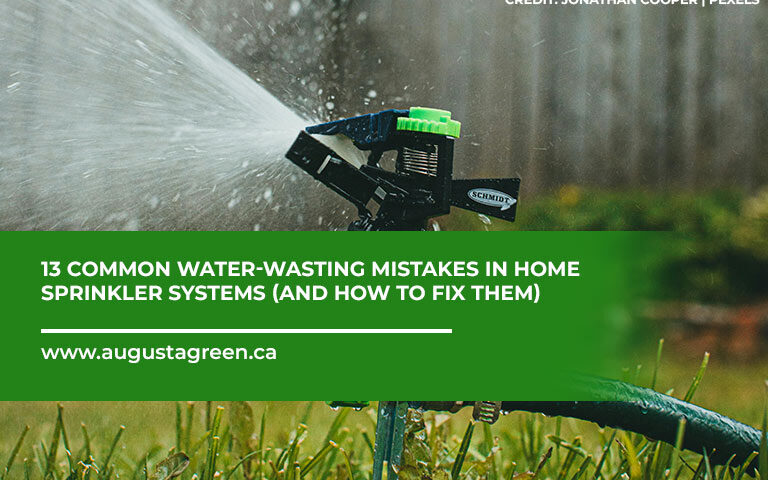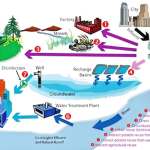Are you tired of seeing your plants wilt despite your best efforts at watering them? It’s frustrating to invest time and energy into your garden only to watch it struggle.
You might be making some common irrigation mistakes without even realizing it. Don’t worry, you’re not alone, and the good news is that these mistakes are easy to fix once you know what to look for. Imagine the satisfaction of lush, thriving plants that make your outdoor space a vibrant oasis.
You’ll discover the most common irrigation pitfalls and, more importantly, how you can correct them. Keep reading to transform your garden into the flourishing paradise you’ve always wanted. Your plants will thank you!
Overwatering Issues
Overwatering is a common mistake in irrigation systems. Many believe more water means healthier plants. But excess water can harm plant health. It leads to root rot and nutrient loss. Understanding overwatering issues is crucial for successful gardening.
Causes Of Overwatering
Overwatering occurs due to frequent watering schedules. Soil type also plays a role. Clay soils retain water longer than sandy soils. Incorrect assessment of plant needs contributes to overwatering. Plants require different amounts of water. Ignoring these differences results in waterlogged soil.
Signs Of Overwatering
Yellow leaves are a common sign. Dropping leaves indicate excess water. Mushy stems and roots are warning signs. Foul odor from the soil suggests decay. Slow growth points to overwatering issues. Recognizing these signs helps prevent damage.
Solutions To Overwatering
Adjust watering schedules based on weather. Use soil moisture sensors for accuracy. Choose plants suited to your soil type. Improve drainage using organic matter. Create channels for excess water to escape. These steps help correct overwatering problems.
Benefits Of Fixing Overwatering
Healthy plants thrive with proper watering. Root systems strengthen without excess moisture. Nutrient uptake improves with balanced water levels. Reducing overwatering saves water resources. Fixing this issue enhances garden health.

Inadequate Coverage
Poor irrigation coverage leads to uneven watering. Plants suffer from stress and inefficient growth. Adjust sprinkler placement to ensure even distribution.
Inadequate coverage in irrigation systems is a common issue that many gardeners and farmers face. It’s frustrating to see patches of your lawn or crops suffer due to uneven water distribution. This problem can arise from a variety of factors, such as incorrect sprinkler placement or improper system design. Understanding the root cause of inadequate coverage is essential to ensure your plants receive the water they need to thrive. Let’s dive into some of the common mistakes and practical solutions you can implement to fix them.Improper Sprinkler Placement
A common mistake is placing sprinklers too far apart. This often leads to dry spots where water doesn’t reach. To fix this, measure the distance that each sprinkler can effectively cover and ensure they overlap slightly. This overlap ensures even water distribution, reducing the risk of dry patches.Incorrect Sprinkler Type
Using the wrong type of sprinkler can cause inefficient watering. For instance, using a fixed spray head in a large area may result in some spots being over-watered while others remain dry. Evaluate your garden or field’s needs, and choose sprinklers designed for your specific area size and shape. This simple change can drastically improve water coverage.Water Pressure Issues
Low water pressure can prevent sprinklers from distributing water evenly. This is often overlooked but easy to correct. Check your system for leaks or blockages that could be reducing water pressure. Consider installing a booster pump if necessary, to maintain adequate pressure throughout your irrigation system.Clogged Nozzles
Clogged nozzles can cause uneven water distribution. This is something you might not notice immediately, but it can have a significant impact over time. Regularly inspect and clean your sprinkler nozzles to ensure they are free from debris and functioning correctly. This simple maintenance task can greatly enhance the efficiency of your irrigation system.System Design Flaws
Sometimes, the issue lies in the original design of the irrigation system. Reflect on whether your system was set up with adequate coverage in mind. If not, it might be time for a redesign. This might seem daunting, but consider consulting with an irrigation professional who can provide guidance tailored to your specific setup. Are there other areas in your garden where you’re noticing inadequate coverage? What steps will you take to address these issues and ensure your plants get the consistent watering they need? Taking the time to identify and fix these common mistakes will lead to a healthier, more vibrant landscape.Timing Errors
Irrigation systems often suffer from timing errors, leading to overwatering or underwatering. These mistakes can harm plant health and waste water. Adjusting timers and scheduling based on plant needs can solve this issue effectively.
Timing errors in irrigation can be a real headache for gardeners and farmers alike. A minor slip-up in the timing of watering can lead to unhealthy plants and wasted resources. When you don’t water your garden at the right time, you might be setting up your plants for failure. It’s crucial to understand the importance of timing to ensure your plants thrive. If you’ve ever noticed your plants looking a little droopy or yellow, take a closer look at your watering schedule. It could be the culprit. Let’s dive into some common timing errors and how you can address them effectively. ###1. Watering At The Wrong Time Of Day
Early mornings are ideal for watering your plants. This timing allows the water to soak into the soil before the sun gets too hot. Watering in the afternoon can lead to evaporation. Evening watering may leave plants wet overnight, inviting disease. Consider setting an alarm or using a timer to ensure you water at dawn. ###2. Inconsistent Watering Schedule
Consistency is key. Watering your plants sporadically can stress them out. A consistent schedule helps plants develop strong roots. They won’t have to adjust to sudden droughts or floods. Try setting a calendar reminder or using an irrigation system with a programmable timer. ###3. Overwatering During Rainy Season
It’s easy to forget about rainfall when you’re following a watering routine. But too much water can suffocate plant roots. Keep an eye on the weather forecast. If rain is expected, skip your usual watering. Invest in a rain sensor for your irrigation system. It will automatically adjust the watering schedule. ###4. Ignoring The Needs Of Different Plants
Not all plants have the same watering needs. Some thrive in dry conditions, while others prefer consistently moist soil. Take the time to research the specific requirements of your plants. Group plants with similar needs together. This small adjustment can save you time and prevent overwatering or underwatering. ###5. Forgetting Seasonal Adjustments
Watering needs change with the seasons. What works in summer might not be suitable for winter. Reduce watering frequency in the cooler months. Plants are usually less active and require less moisture. Adjust your irrigation settings according to the season’s demands. — Have you been guilty of any of these timing errors? Recognizing these mistakes is the first step toward healthier plants. Implementing these tips can not only improve plant health but also conserve water. Remember, the right timing can make all the difference in your garden’s success.
Maintenance Neglect
Neglecting regular maintenance in irrigation systems leads to issues like leaks and uneven watering. Regular checks and cleaning prevent these problems. Proper care ensures plants receive the right amount of water, promoting healthy growth.
Maintaining an efficient irrigation system is crucial for a thriving garden or lawn. Yet, maintenance neglect is a common mistake that can lead to various issues, from dry patches to water wastage. Many gardeners often overlook regular checks and repairs, thinking their system is self-sustaining. However, just like any other equipment, irrigation systems require attention and care. Without it, you could be throwing money down the drain and risking the health of your plants. So, how can you keep your irrigation system in top shape?Inspect Your Equipment Regularly
Regular inspection is key to identifying problems early. Check for leaks, clogs, or broken parts. A small leak can turn into a big problem if left unattended. Is your sprinkler head not spraying as it should? This could be due to a blockage or wear and tear. Address these issues promptly to prevent further damage.Clean Filters And Nozzles
Dirt and debris can accumulate over time, clogging filters and nozzles. This can reduce water flow and efficiency. Make it a habit to clean them regularly. A simple rinse under running water can often do the trick. If you’ve ever noticed uneven watering, a clogged nozzle might be the culprit.Adjust Sprinkler Heads For Optimal Coverage
Sprinkler heads can shift or become misaligned, leading to uneven watering. This can create dry patches or waterlogged areas. Adjust the heads to ensure they cover the intended area. It’s a small tweak but can make a big difference in water distribution.Check For Leaks
Leaks are a silent drain on resources. They can go unnoticed until your water bill spikes or you see soggy spots in your yard. Regularly check hoses, connections, and valves for any signs of leakage. Fixing leaks promptly can save you water and money.Monitor Water Pressure
Water pressure that’s too high or too low can affect your irrigation system’s performance. High pressure can cause sprinklers to mist, leading to evaporation and water waste. Low pressure might not provide adequate coverage. Use a pressure gauge to check and adjust the pressure as needed.Winterize Your System
In colder climates, failing to winterize your irrigation system can lead to frozen pipes and costly repairs. Before the first freeze, drain the system and insulate any exposed parts. This simple step can protect your investment and ensure it’s ready for the next growing season. Neglecting maintenance can lead to a host of problems, but it doesn’t have to be overwhelming. By taking these simple steps, you can keep your irrigation system running efficiently and avoid costly repairs. What steps will you take today to ensure your system is in top condition?
Conclusion
Avoiding irrigation mistakes can boost your garden’s health. Properly maintain your system. Check for leaks often. Adjust timers with the seasons. Test soil moisture before watering. These small efforts keep plants thriving. Save water and energy too. Remember, every garden is unique.
Tailor your approach to its needs. Seek advice if unsure. A little attention goes a long way in gardening. Enjoy the beauty of a well-watered landscape. Your plants will thank you. Happy gardening!


